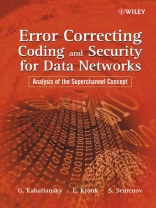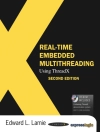Error correcting coding is often analyzed in terms of its
application to the separate levels within the data network in
isolation from each other. In this fresh approach, the
authors consider the data network as a superchannel (a
multi-layered entity) which allows error correcting coding to be
evaluated as it is applied to a number of network layers as a
whole. By exposing the problems of applying error correcting
coding in data networks, and by discussing coding theory and its
applications, this original technique shows how to correct errors
in the network through joint coding at different network
layers.
* Discusses the problem of reconciling coding applied to
different layers using a superchannel approach
* Includes thorough coverage of all the key codes: linear block
codes, Hamming, BCH and Reed-Solomon codes, LDPC codes decoding, as
well as convolutional, turbo and iterative coding
* Considers new areas of application of error correcting codes
such as transport coding, code-based cryptosystems and coding for
image compression
* Demonstrates how to use error correcting coding to control such
important data characteristics as mean message delay
* Provides theoretical explanations backed up by numerous
real-world examples and practical recommendations
* Features a companion website containing additional research
results including new constructions of LDPC codes, joint
error-control coding and synchronization, Reed-Muller codes and
their list decoding
By progressing from theory through to practical problem solving,
this resource contains invaluable advice for researchers,
postgraduate students, engineers and computer scientists interested
in data communications and applications of coding theory.
Table des matières
Preface.
1 Problems Facing Error Control Coding in Data
Networks.
1.1 International Recommendations on Using Error Control Coding
at Different Network Layers.
1.2 Classification of Problems on Coding in Networks.
2 Block Codes.
2.1 Main Definitions.
2.2 Algebraic Structures.
2.3 Linear Block Codes.
2.4 Cyclic Codes.
2.5 Bounds on Minimum Distance.
3 General Methods of Decoding of Linear Codes.
3.1 Minimum Distance Decoding.
3.2 Information Set Decoding.
3.3 A Supercode Decoding Algorithm.
3.4 The Complexity of Decoding in the Channel with Independent
Errors.
4 Codes with Algebraic Decoding.
4.1 Hamming Codes.
4.2 Reed-Solomon Codes.
4.3 BCH Codes.
4.4 Decoding of BCH Codes.
4.5 The Sudan Algorithm and its Extensions.
5 Decoding of LDPC Codes.
5.1 Low-Density Parity-Check Codes.
5.2 LDPC Constructions.
5.3 Estimating the Minimum Distance of EG-LDPC Codes.
5.4 Burst-Error-Correcting LDPC Codes.
5.5 Decoding Schemes of LDPC Codes.
5.6 Simulation Results in AWGN.
Appendix 5.A Euclidean Geometries.
6 Convolutional Codes and Turbo-Codes.
6.1 Convolutional Codes Representation and Encoding.
6.2 Viterbi Decoding Algorithm.
6.3 List Decoding.
6.4 Sequential Decoding.
6.5 Parallel-Concatenated Convolutional Codes and Soft Input
Soft Output Decoding.
6.6 SISO Decoding Algorithms.
7 Coding of Messages at the Transport Layer of the Data
Network.
7.1 Decreasing the Message Delay with the help of Transport
Coding.
7.2 Transmission of Message during Limited Time.
7.3 Transmission of Priority Messages without using Priority
Packets .
7.4 Estimation of the Effectiveness of Transport Coding for the
Nonexponential Model of Packet Delay.
8 Providing Security of Data in a Network with the Help of
Coding Methods.
8.1 Public-Key Cryptography.
8.2 Codebased Cryptosystems: Mc Eliece and Niederreiter.
8.3 Cryptosystems Based on Full Decoding.
8.4 Further Development of Codebased Cryptosystems.
8.5 Codebased Cryptosystems and RSA: Comparison and
Perspectives.
8.6 Codebased Signature.
9 Reconciliation of Coding at Different Layers of a
Network.
9.1 Transport Coding in a Network with Unreliable Channels.
9.2 Reconciliation of Channel and Transport Coding.
9.3 Use of Tornado Codes for Reconciliation of Channel and
Transport Coding.
9.4 Development of Coding Methods at the Presentation Layer.
9.5 Reconciliation of Coding at Neighbour Layers of a
Network.
Index.
A propos de l’auteur
Grigorii Kabatiansky is the author of Error Correcting Coding and Security for Data Networks: Analysis of the Superchannel Concept, published by Wiley.
Professor Evgenii Krouk has worked in the field of communication theory and techniques for more than 30 years. His areas of interests are coding theory, the mathematical theory of communications and cryptography. He is now the Dean of the Information Systems and Data Protection Faculty of the Saint-Petersburg State University of Aerospace Instrumentation. He is author of 3 books, more than 100 scientific articles and 30 international and Russian patents.
Sergei Semenov received his Ph.D. degree from St.-Petersburg State University for Airspace Instrumentation (SUAI), Russia in 1993. Dr. Semenov joined Nokia Corporation in 1999 and is currently a Specialist in Modem Algorithm Design/Wireless Modem. His research interests include coding and communication theory and their application to communication systems.












